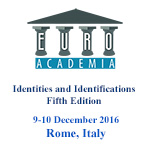Euroacademia Conferences
 Europe Inside-Out: Europe and Europeanness Exposed to Plural Observers (9th Edition) April 24 - 25, 2020
Europe Inside-Out: Europe and Europeanness Exposed to Plural Observers (9th Edition) April 24 - 25, 2020 Identities and Identifications: Politicized Uses of Collective Identities (9th Edition) June 12 - 13, 2020
Identities and Identifications: Politicized Uses of Collective Identities (9th Edition) June 12 - 13, 2020 8th Forum of Critical Studies: Asking Big Questions Again January 24 - 25, 2020
8th Forum of Critical Studies: Asking Big Questions Again January 24 - 25, 2020 Re-Inventing Eastern Europe (7th Edition) December 13 - 14, 2019
Re-Inventing Eastern Europe (7th Edition) December 13 - 14, 2019 The European Union and the Politicization of Europe (8th Edition) October 25 - 26, 2019
The European Union and the Politicization of Europe (8th Edition) October 25 - 26, 2019 Identities and Identifications: Politicized Uses of Collective Identities (8th Edition) June 28 - 29, 2019
Identities and Identifications: Politicized Uses of Collective Identities (8th Edition) June 28 - 29, 2019 The European Union and the Politicization of Europe (7th Edition) January 25 - 26, 2019
The European Union and the Politicization of Europe (7th Edition) January 25 - 26, 2019 7th Forum of Critical Studies: Asking Big Questions Again November 23 - 24, 2018
7th Forum of Critical Studies: Asking Big Questions Again November 23 - 24, 2018 Europe Inside-Out: Europe and Europeanness Exposed to Plural Observers (8th Edition) September 28 - 30, 2018
Europe Inside-Out: Europe and Europeanness Exposed to Plural Observers (8th Edition) September 28 - 30, 2018 Identities and Identifications: Politicized Uses of Collective Identities (7th Edition) June 14 - 15, 2018
Identities and Identifications: Politicized Uses of Collective Identities (7th Edition) June 14 - 15, 2018
Treatment of Minorities in the Media – Visualizing the Other
-
-

-
Presentation speakers
- Emmanuelle Bruneel, CELSA Paris-Sorbonne, France
- Download presentation
Abstract:
This contribution aims to discuss the political uses of the ‘diversity’s rhetoric’ in the French communication and media context. I will try to point out what kind of visual representation of ‘minorities’ is given that way, questioning which idea of alterity is conveyed in that specific visual discourse? In France, the minorities’ struggle for visibility (Voirol Olivier) takes place in the media and communication scope because it is the most important providing source of visibility and a political hegemonic (Gramsci Antonio) support. Visibility and visuality (Mirzoeff Nicholas) are highly at stake in the minorities’ representation issue. I will investigate the way the ‘diversity’ discourse (Sénac Réjane, 2012) is textually formulated and visually designed and what it stands for in the French media and political sphere. Indeed, many publicized documents focus on ‘promoting diversity’ to say that nobody is discriminated and that the collective identity is plural. They are part of communication strategies and deliver a positive discourse about how enlightening it is to collect many different people with various identities. It argues that ‘diversity’ is accomplished whenever all the components of the population are represented or ‘made more visible’. The accompanying pictures represent groups (within which there are a lot of coloured people or just colours) in a very enchanting way. Plus, the social injunction : “visible minorities have to be made more visible”, sounds as a paradox. That double bind allows visual representation to underline the most visible aspect : multicolour becomes a significant for ‘multiracial society’, in a way that is euphemistic and depoliticized. Then, the visual representation of ‘diversity’ strengthens a colourful idea of ‘diversity’, dealing with an emphatic representation of ‘race’. It also seems to be very mediagenic (Marion Philippe, 1997) and can be considered as a communication tool to avoid the contentious political question of social injustice and hegemonic domination. So, questioning that visual material (WJT Mitchell) intending to represent ‘diversity’ is leading us to re-investigate the tension between the French republican model and the multicultural society designed by globalisation dynamics. We will argue that ‘diversity’ is a depoliticized visual concept in the French context.
-
Related Presentations













